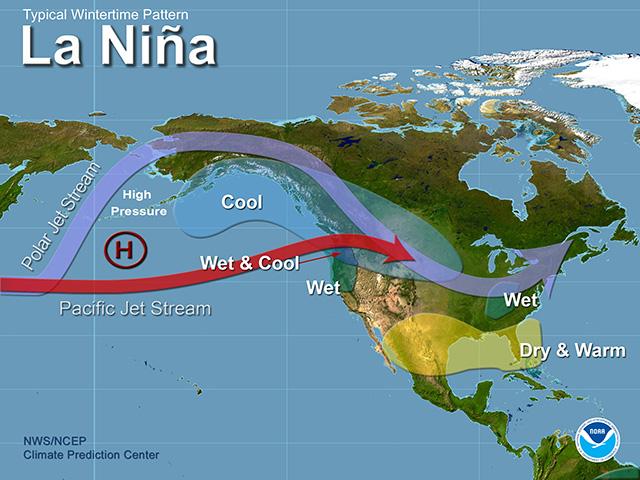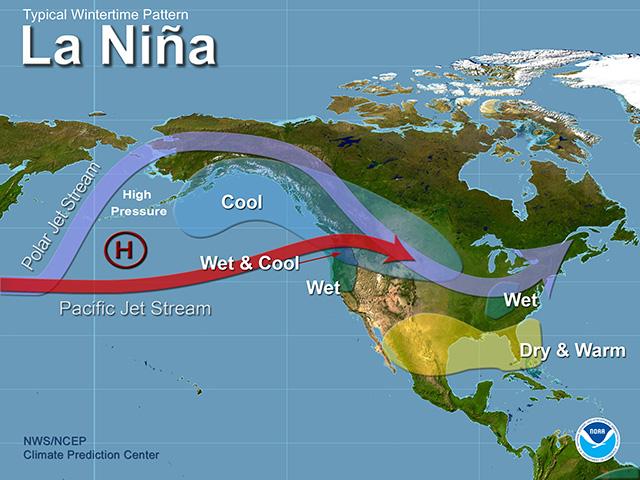Ag Weather Forum
5 Things to Know About a Developing La Nina
It has been on the proverbial radar for a while now, but El Nino is going through a rapid decay and is set to become La Nina this summer. Ocean temperatures in the tropical Pacific Ocean had been significantly warmer than normal, producing what meteorologists colloquially call a "super" El Nino, when sea-surface temperatures reach 2 degrees Celsius above normal.
That has only been accomplished five other times in records going back to 1950 and had a tremendous effect on the weather pattern during winter. It was a consistent textbook case of the event with well-above normal temperatures across the northern tier of the country and a very active southern jet stream that brought lots of precipitation to the southern tier of the country.
The abrupt decline of those ocean temperatures to below normal is coming courtesy of a blob of cold water underneath the surface which moved from Australia eastward during the winter and breached the surface during the last couple of weeks here in March. The expansion of that colder water should make for some sort of La Nina event developing this summer. Model simulations suggest a rapid onset early this summer, reaching the criteria needed of 0.5 degrees C below normal by early June, according to the American CFS model.
There are some questions about the speed and intensity of La Nina developing this summer. And as DTN Ag Meteorologist Emeritus Bryce Anderson noted here in his most recent blog, (https://www.dtnpf.com/…), not all of the models and forecasts are on board. The Australian Bureau of Meteorology is more skeptical about the developing La Nina -- but it seems to be the only outlet that is. There is a high degree of evidence that La Nina will develop this summer, regardless.
And we shouldn't be surprised of a La Nina developing this year. In the other five instances of a super El Nino, they were followed by La Nina in four of those years. The fifth didn't quite make the criteria, though below-normal temperatures developed in the summer and fall. So, with La Nina seemingly on the way, what does that mean for the weather patterns this summer and beyond? Here are five big takeaways for the coming event.
1. THE INFLUENCE OF LA NINA WILL TAKE SOME TIME
Like the switch from La Nina to El Nino in 2023, the change back to La Nina will take some time for the atmosphere to respond. Ocean temperatures are still above normal in the Pacific, though they are declining rapidly. But the atmosphere will take weeks to change to the new conditions. The faster that change occurs, the quicker we set up the main effects of La Nina. If La Nina develops at the start of June, as the American CFS model implies, then we may not see the direct impacts until July. That does not mean there will be no tendency or brief stir-ups that may look like La Nina, but the sustained impacts usually happen much later.
2. THE EFFECTS OF LA NINA HAVE THE MOST IMPACT DURING NORTHERN HEMISPHERE WINTER
P[L1] D[0x0] M[300x250] OOP[F] ADUNIT[] T[]
The most consistent impacts from La Nina occur about three to six months after it initializes, during the Northern Hemisphere winter. That goes for those south of the equator as well. While changes are going to be occurring over the next few months, the main impacts we will notice and attribute to La Nina will come between November and March. That mostly means more cold shots from Canada and a drier southern tier of the U.S., mostly opposite of what El Nino did for us this winter.
3. LA NINA PROMOTES STAGNANT PATTERNS
La Nina usually produces stagnant blocking patterns in the upper troposphere. Blocking high-pressure ridges develop and sit around, sometimes for weeks at a time before relenting. And when they do, they don't shift around very long before redeveloping.
In the summer, that ridge tends to situate somewhere over North America, making for a hot season for those who are underneath it. But North America is pretty big and we could see that ridge shift around a bit.
In the winter, that ridge tends to form in the Gulf of Alaska and farther north, as well as the North Atlantic. Usually, that means a trough across North America and colder air flowing down from Canada behind a series of clippers. It could make the Pacific Northwest and Ohio Valley wetter than normal, but it tends to dry out the southern tier of the country while keeping that area more protected from the cold from the north on most occasions.
4. HISTORY SUGGESTS HOT SUMMERS IN THE US
That ridge during summer makes for high heat to build across the U.S. and could last for weeks at a time, depending on precipitation and soil moisture. Precipitation can cut into the overall heat the ridge produces, and other factors will affect the summer weather besides La Nina. And not every La Nina is the same. We had three straight La Ninas from 2020-2022 and each of those summers had its own weather challenges.
North America is large and ridges can't envelop the entire continent. If the ridge is centered over the Rockies and Plains, they get hot and dry while the East is cooler and wetter. If it is centered toward the East, the East Coast bakes while the Plains and Upper Midwest get some needed rainfall. Both can be true at once and we could see both of these events occurring over the summer. Which configuration will be more dominant will be most important for summer weather and timing will be key for agriculture. A good mix of both would be the best outcome for the U.S., but it probably will not work out that way.
However, when we look at history of summer weather during building La Nina, what we typically see is a consistent hot signature over the middle of the U.S. during June that shifts more toward the eastern U.S. for July and August.
The good news is that some of this heat could be dampened because of an increase of precipitation. During those summers with La Nina developing, precipitation was active across the northern tier of the U.S. in June, over the South-Central U.S. in July, and sort of widespread or active east of the Rockies during August. That may not be as true across the Plains and East Coast as the Mississippi Valley during August, but it appears most areas have produced some period of above-normal precipitation during the summer.
No doubt some areas are going to be left out, and drought is likely to develop somewhere. But it is nearly impossible to predict where. The best idea is to continue drought where it is currently located, centered around Iowa in the Upper Midwest. But we could see it building anywhere. I, myself, am concerned more about the Plains as the summer of 2020 -- the last time we saw El Nino flip to La Nina -- meant heat and drought that hasn't really gone away since.
5. LA NINA INCREASES TROPICAL STORM ACTIVITY
Throwing a wrench into the precipitation forecast, though, is the effect La Nina has on tropical storm development. Typically, La Nina favors an increase in tropical storm activity in the Northern Hemisphere by reducing shear. Shear, which describes the change in wind direction and speed with height, is a negative factor in tropical storms. It tends to shred apart thunderstorm clusters in the tropics when those thunderstorms are necessary to consolidate to form a tropical storm.
For an Atlantic Basin where sea-surface temperatures are already reminiscent of summer, the ingredients should be there for an active season. We could see some early storm systems as well, based on the warm waters alone. Throw in the effects from La Nina and we could see a rather active pattern in the Atlantic.
That does not mean tropical storms and hurricanes are destined for the U.S., but if they do occur near the shore, it could bring heavy rainfall to areas that either need it or cause some flooding damage inland from the coasts.
Historically, the East Coast and Florida are favored early in the season while the Gulf of Mexico gains influence later in the season. But that does not mean that a Gulf storm couldn't happen early. In fact, when tropical storms happen early in the season like June and July, they are typically found in the Gulf of Mexico or off the coast of Florida, where spring cold fronts stall out in the area.
To find more weather conditions and your local forecast from DTN, head over to https://www.dtnpf.com/…
John Baranick can be reached at john.baranick@dtn.com
(c) Copyright 2024 DTN, LLC. All rights reserved.






Comments
To comment, please Log In or Join our Community .